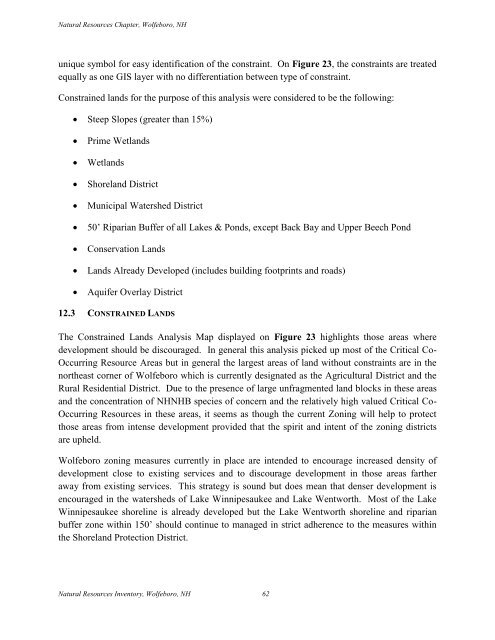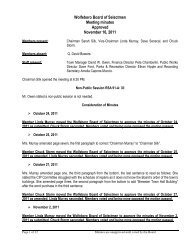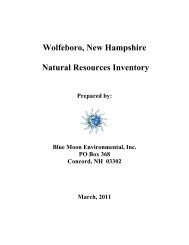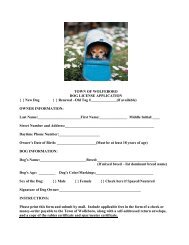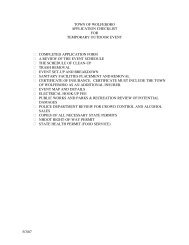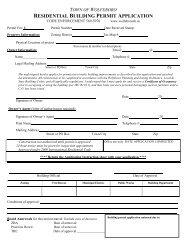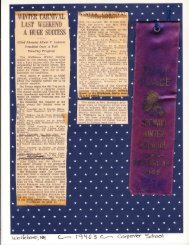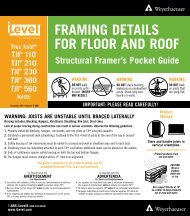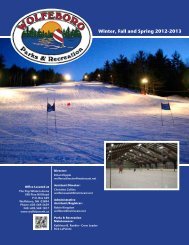Natural Resources Chapter of the Master Plan - Town of Wolfeboro
Natural Resources Chapter of the Master Plan - Town of Wolfeboro
Natural Resources Chapter of the Master Plan - Town of Wolfeboro
Create successful ePaper yourself
Turn your PDF publications into a flip-book with our unique Google optimized e-Paper software.
<strong>Natural</strong> <strong>Resources</strong> <strong>Chapter</strong>, <strong>Wolfeboro</strong>, NH<br />
unique symbol for easy identification <strong>of</strong> <strong>the</strong> constraint. On Figure 23, <strong>the</strong> constraints are treated<br />
equally as one GIS layer with no differentiation between type <strong>of</strong> constraint.<br />
Constrained lands for <strong>the</strong> purpose <strong>of</strong> this analysis were considered to be <strong>the</strong> following:<br />
Steep Slopes (greater than 15%)<br />
<br />
<br />
<br />
<br />
<br />
<br />
<br />
<br />
Prime Wetlands<br />
Wetlands<br />
Shoreland District<br />
Municipal Watershed District<br />
50‟ Riparian Buffer <strong>of</strong> all Lakes & Ponds, except Back Bay and Upper Beech Pond<br />
Conservation Lands<br />
Lands Already Developed (includes building footprints and roads)<br />
Aquifer Overlay District<br />
12.3 CONSTRAINED LANDS<br />
The Constrained Lands Analysis Map displayed on Figure 23 highlights those areas where<br />
development should be discouraged. In general this analysis picked up most <strong>of</strong> <strong>the</strong> Critical Co-<br />
Occurring Resource Areas but in general <strong>the</strong> largest areas <strong>of</strong> land without constraints are in <strong>the</strong><br />
nor<strong>the</strong>ast corner <strong>of</strong> <strong>Wolfeboro</strong> which is currently designated as <strong>the</strong> Agricultural District and <strong>the</strong><br />
Rural Residential District. Due to <strong>the</strong> presence <strong>of</strong> large unfragmented land blocks in <strong>the</strong>se areas<br />
and <strong>the</strong> concentration <strong>of</strong> NHNHB species <strong>of</strong> concern and <strong>the</strong> relatively high valued Critical Co-<br />
Occurring <strong>Resources</strong> in <strong>the</strong>se areas, it seems as though <strong>the</strong> current Zoning will help to protect<br />
those areas from intense development provided that <strong>the</strong> spirit and intent <strong>of</strong> <strong>the</strong> zoning districts<br />
are upheld.<br />
<strong>Wolfeboro</strong> zoning measures currently in place are intended to encourage increased density <strong>of</strong><br />
development close to existing services and to discourage development in those areas far<strong>the</strong>r<br />
away from existing services. This strategy is sound but does mean that denser development is<br />
encouraged in <strong>the</strong> watersheds <strong>of</strong> Lake Winnipesaukee and Lake Wentworth. Most <strong>of</strong> <strong>the</strong> Lake<br />
Winnipesaukee shoreline is already developed but <strong>the</strong> Lake Wentworth shoreline and riparian<br />
buffer zone within 150‟ should continue to managed in strict adherence to <strong>the</strong> measures within<br />
<strong>the</strong> Shoreland Protection District.<br />
<strong>Natural</strong> <strong>Resources</strong> Inventory, <strong>Wolfeboro</strong>, NH 62


